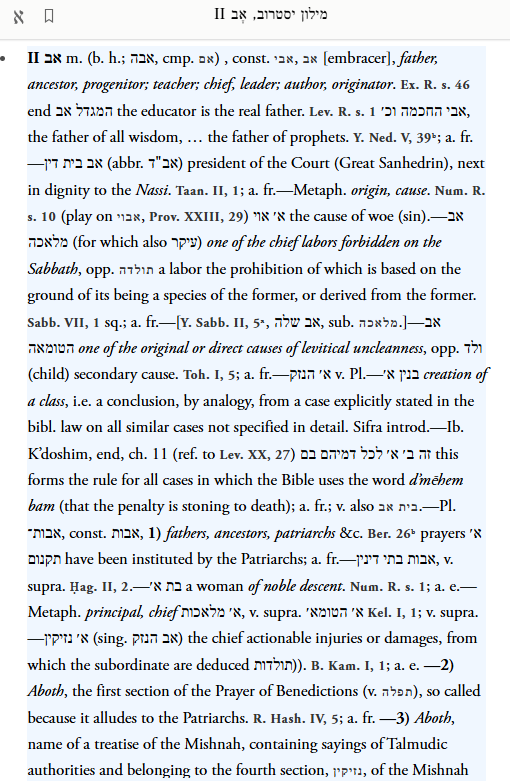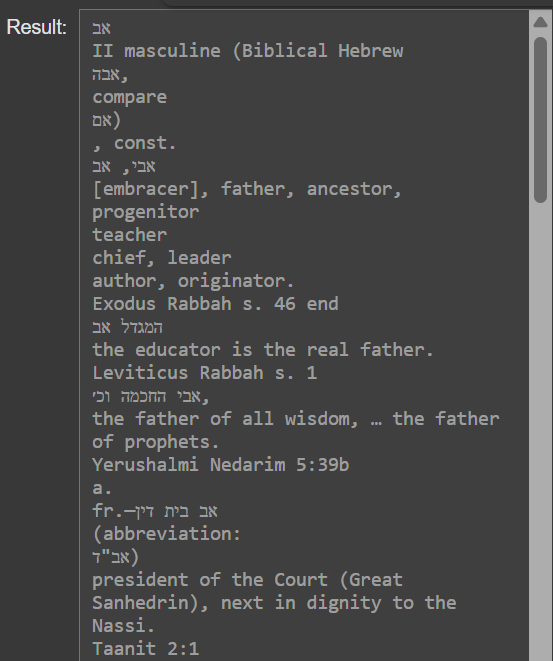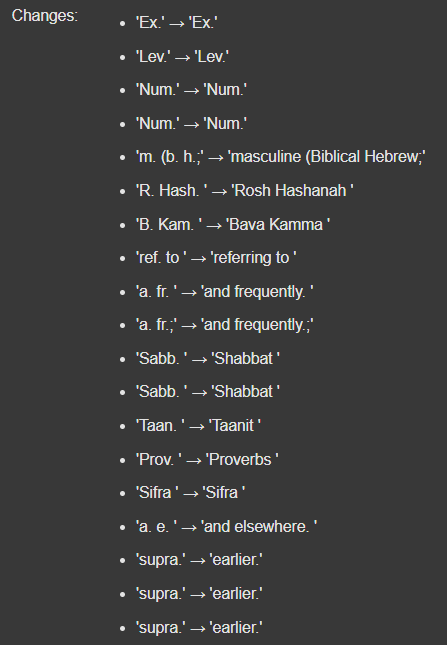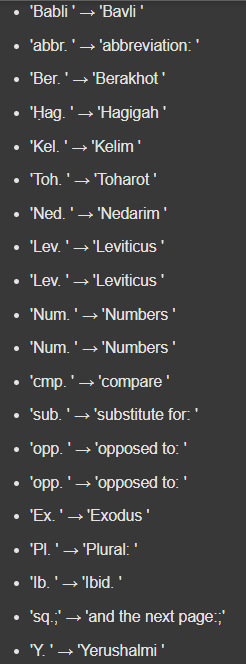Decoding Jastrow's Dictionary: A Modern Guide to an Essential Talmudic Resource
With Appendix - A Comprehensive Mapping table of Jastrow Dictionary’s Abbreviations (~18pp.)
Jastrow's Dictionary is an invaluable resource for Talmudic studies despite its age. Though not perfect, it is open access and remains (in my opinion) underappreciated, with many features not understood by the average reader (myself included until recently).
Jastrow Dictionary’s Abbreviations
The fundamental challenge with the dictionary for the modern reader are the huge number of abbreviations, many of which use archaic English and Latin words, and archaic transliterations of Hebrew.
In the appendix to this piece, I present an extensive mapping ‘dictionary’ that expands Jastrow's abbreviations into contemporary terminology. Notably, most of these abbreviations aren't included in Jastrow's own abbreviation list.
Outline
Jastrow Dictionary’s Abbreviations
The Language of Another Era: Jastrow's Archaisms and the Case for Modernization
Essential Abbreviation mapping
Transliteration
Outdated Linguistic Terminology
Latinisms and Classical References
Archaic English
Reference Systems
Other Archaisms and Particularities
Automated Modernization Tool: My Jastrow Modernizer Script
Jastrow Modernization Case Study - Modernized with script and additional manual optimization
Appendix - A Comprehensive Mapping table of Jastrow Dictionary’s Abbreviations
# Talmudic Tractates (including titles of Minor tractates and Sedarim)
# Biblical Books
# Midrashic and Rabbinic Literature
# Torah Portions (including titles / incipits of Midrashic ‘parashot’)
# Other Primary Sources
# Manuscripts and printed editions, by collection location and editor name
# Secondary Literature
# Grammatical and linguistics Terms
# General, Miscellaneous, Reference Notations, and Analytical Terms
The Language of Another Era: Jastrow's Archaisms and the Case for Modernization
Jastrow's Dictionary, published in 1903, is written in the scholarly language of the late 19th century—a dialect increasingly foreign to modern readers.
Examining the extensive mapping table (at the end of this piece, in the Appendix) reveals just how dramatically academic language has evolved in the past century, creating significant barriers for today's learners.
Essential Abbreviation mapping
b.h. = biblical Hebrew
ch. = Chaldean, i.e. Aramaic1
m. = masculine (grammatical gender)
f. = feminine (grammatical gender)
&c. = etc.
v. = see
w. = word
s. = section
a. l. = ad. loc.
ib. = ibid.
a. fr. = and frequently
a. e. = and elsewhere
Y. = Yerushalmi
Rabb. D. S. = Rabbinowitz, ‘Dikdukei Soferim’2
Transliteration
Jastrow's transliteration system for Hebrew and Aramaic is difficult by today's standards. These inconsistencies make it difficult for students to connect dictionary entries with the same terms in modern texts.
Outdated Linguistic Terminology
Perhaps most fundamentally, Jastrow employs linguistic terminology that has been abandoned or revised. His use of "Chald." (Chaldean) instead of "Aramaic" reflects 19th-century philological conventions.
Latinisms and Classical References
Jastrow's text is saturated with Latin abbreviations that were once common but now are archaic: "Ib." (Ibid.), "a. l." (ad locum), "q.v." (quod vide). He employs "v." for "see"3 and "&c." for "etc."
Archaic English
The dictionary employs archaic English pronouns and vocabulary throughout: "thee," "thou," "thine" instead of modern "you" and "your"; "betimes" for "in a timely way." His spelling conventions (like "poëtic" with a diaeresis) and terminology choices ("heathen" instead of "pagan"; “gentile” instead of “non-Jew”) further distance modern readers.4
Reference Systems
The complex reference system using tiny superscripts (4ᵇ for page 4, side b) and abbreviations for manuscripts and editions ("Ms. F." for "Manuscript Florence") creates a maze that only specialists can (possibly) navigate. Manuscript collections are cited by city abbreviations that assume familiarity with European library geography.
Other Archaisms and Particularities
Extensive usage of Roman numerals. Especially used for chapter numbers (Bible chapter #, Mishnah and Tosefta chapter #, etc.)
Word abbreviation: For the word under discussion, Jastrow abbreviates using just the first letter (e.g., see my case study later in this piece, entry מקלה, that word is abbreviated as מ')
Source splitting: Jastrow divides sources with periods, but it’s often hard to read. Ideally, would be split into paragraphs (see my case study).
Automated Modernization Tool: My Jastrow Modernizer Script
I've developed a Jastrow Dictionary Abbreviation Modernizer script.5
Screenshots, for example
Screenshot of that entry in Sefaria:
Screenshot, of the output ‘result’ that entry, in my tool:
Screenshot of output list of ‘changes’ (=mappings), in my tool:
Jastrow Modernization Case Study - Modernized with script and additional manual optimization
Taken from a footnote in my recent piece: “Pt2 Power, Pedagogy, and Internal Rabbinic Politics: The Deposition of Rabban Gamliel, the Appointment of R' Elazar ben Azarya, and Eventual Reconciliation (Berakhot 27b-28a)”:
Entry מקלה, original, as appears at Sefaria:
Original, screenshot:
Original, text:
מקלה m. (קלה II) roasting place; אפר מ׳ ashes from the roast, i.e. vegetable ashes, contrad. to אפר which includes any crumbled substance. Taan. II, 1. Ib. 15ᵇ (ref. to ונותנין אפר וכ׳, ib.) אפר מ׳ הן מביאין they must bring wood-ashes (not dust, crushed bones &c.). Par. IX, 7 אפר כשר שנתערב באפר מ׳ ashes fit for lustration (ashes of the red cow) which were mixed with wood-ashes. Tosef. ib. X (IX), 1 הרי הן כא׳ מ׳ they are as unfit for lustration as wood-ashes. Ber. 28ᵃ, a. e., v. מוה II.
מקלה ch. same Targ. Lam. II, 10.—[B. Mets. 74ᵃ מחוסר מקלה, v. קלי II.]
Modernized (with script and additional manual optimization):
מקלה - masculine - (קלה II) - “roasting place”
אפר מקלה - ashes from the roast, i.e. “vegetable [=plant] ashes”, contrasted to אפר which includes any crumbled substance.
Taanit 2:1
Ibid. 15b (referring to ונותנין אפר וכו׳, ibid.) - אפר מקלה הן מביאין - “they must bring wood-ashes (not dust, crushed bones etc.).”
Parah 9:7 - אפר כשר שנתערב באפר מקלה - “ashes fit for lustration [=purification] (ashes of the red cow [=red heifer]) which were mixed with wood-ashes.”
Tosefta ibid. 10 (9):1 - הרי הן כאפר מקלה - “they are as unfit for lustration as wood-ashes.”
Berakhot 28a
and elsewhere
see מזה sense #2.
מקלה
Aramaic, same sense as previous entry
Targum Lamentations 2:10.
[Bava Metzia 74a - מחוסר מקלה,
see קלי sense #2.]
Appendix - A Comprehensive Mapping table of Jastrow Dictionary’s Abbreviations
(See footnote)6
mapping_dict = {
# Talmudic Tractates (including titles of Minor tractates and Sedarim)
# https://en.wikipedia.org/wiki/Category:Mishnah
"Ab.": "Avot",
"Ab. Zar.": "Avodah Zarah",
"Arakh.": "Arakhin",
"B. Bath.": "Bava Batra",
"B. Kam.": "Bava Kamma",
"B. Mets.": "Bava Metzia",
"Bekh.": "Bekhorot",
"Ber.": "Berakhot",
"Bets.": "Beitzah",
"Bicc.": "Bikkurim",
"Dem.": "Demai",
"Ed.": "Eduyot",
"Erub.": "Eruvin",
"Gitt.": "Gittin",
"Ḥag.": "Hagigah",
"Ḥăgigah": "Hagigah",
"Ḥall.": "Hallah",
"Hor.": "Horayot",
"Ḥull.": "Hullin",
"Kel.": "Kelim",
"Ker.": "Keritot",
"Keth.": "Ketubot",
"Kidd.": "Kiddushin",
"Kid.": "Kiddushin",
"Kil.": "Kilayim",
"Kin.": "Kinnim",
"M. Kat.": "Moed Katan",
"Maas. Sh.": "Maaser Sheni",
"Maasr.": "Maasrot",
"Macc.": "Makkot",
"Makhsh.": "Makhshirin",
"Meg.": "Megillah",
"Meil.": "Meilah",
"Men.": "Menahot",
"Midd.": "Middot",
"Mikv.": "Mikvaoth",
"Toh.": "Toharot",
"Mikh.": "Mikvaot",
"Naz.": "Nazir",
"Ned.": "Nedarim",
"Neg.": "Negaim",
"Nidd.": "Niddah",
"Ohol.": "Oholot",
"Orl.": "Orlah",
"Par.": "Parah",
"Pes.": "Pesahim",
"R. Hash.": "Rosh Hashanah",
"Rosh. Hash.": "Rosh Hashanah",
"Sabb.": "Shabbat",
"Sanh.": "Sanhedrin",
"Shebi.": "Sheviit",
"Shebu.": "Shevuot",
"Shek.": "Shekalim",
"Snh.": "Sanhedrin",
"Sot.": "Sotah",
"Succ.": "Sukkah",
"Taan.": "Taanit",
"Tam.": "Tamid",
"T’bul Yom": "Tevul Yom",
"Teb. Yom": "Tevul Yom",
"Tem.": "Temurah",
"Ter.": "Terumot",
"Ukts.": "Uktzin",
"Yad.": "Yadayim",
"Yeb.": "Yevamot",
"Zab.": "Zavim",
"Zeb.": "Zevahim",
"Abadim": "Avadim",
"Sof’rim": "Soferim",
"N’zik.": "Nezikin",
"N’zikin": "Nezikin",
"N’ziḳin": "Nezikin",
"Z’raïm": "Zeraim",
"Z’raʿim": "Zeraim",
"Der. Er.": "Derekh Erets",
# Biblical Books
# https://en.wikipedia.org/wiki/Template:Tanakh_OT
"Am.": "Amos",
"Cant.": "Shir HaShirim",
"Chron.": "Chronicles",
"Chr.": "Chronicles",
"Dan.": "Daniel",
"Deut.": "Deuteronomy",
"Esth.": "Esther",
"Ex.": "Exodus",
"Ez.": "Ezekiel",
"Gen.": "Genesis",
"Hab.": "Habakkuk",
"Hos.": "Hosea",
"Is.": "Isaiah",
"Jer.": "Jeremiah",
"Jon.": "Jonah",
"Josh.": "Joshua",
"Jud.": "Judges",
"Koh.": "Kohelet",
"Lam.": "Lamentations",
"Lev.": "Leviticus",
"Mal.": "Malachi",
"Mic.": "Micah",
"Nah.": "Nahum",
"Neh.": "Nehemiah",
"Num.": "Numbers",
"Ob.": "Obadiah",
"Prov.": "Proverbs",
"Ps.": "Psalms",
"Pss.": "Psalms",
"Sam.": "Samuel",
"Zech.": "Zechariah",
"Zeph.": "Zephaniah",
# Midrashic and Rabbinic Literature
# https://en.wikipedia.org/wiki/Template:Rabbinic_Literature
"Ag. Hatt.": "Agadot HaTorah",
"Cant. R.": "Shir HaShirim Rabbah",
"Deut. R.": "Deuteronomy Rabbah",
"Esth. R.": "Esther Rabbah",
"Ex. R.": "Exodus Rabbah",
"Gen. R.": "Genesis Rabbah",
"Koh. R.": "Kohelet Rabbah",
"Lam. R.": "Lamentations Rabbah",
"Lev. R.": "Leviticus Rabbah",
"Mekh.": "Mekhilta",
"Midr.": "Midrash",
"Midr. Sam.": "Midrash Samuel",
"Midr. Till.": "Midrash Tehillim",
"Num. R.": "Numbers Rabbah",
"Pesik.": "Pesikta",
"Pesik. R.": "Pesikta Rabbati",
"Pesik. Zutr.": "Pesikta Zutrathi, ed. Buber", # Lekach Tov
"Pirkê d’R. El.": "Pirkei d’Rabbi Eliezer",
"Ruth R.": "Ruth Rabbah",
"S’maḥ.": "Semahot",
"Sifra": "Sifra",
"Sifré": "Sifre",
"Tanḥ.": "Midrash Tanḥuma",
"Y’lamd.": "Yelamdenu", # Midrash Tanḥuma
"Yalk.": "Yalkut",
"Ab. d’R. N.": "Avot d’Rabbi Natan",
"Seder Ol. R.": "Seder Olam Rabbah",
"Seder Ol. Z.": "Seder Olam Zutta",
"Midr. HaG.": "Midrash HaGadol",
"Tanna d’Bei El.": "Tanna Devei Eliyahu",
"Sef. Yets": "Sefer Yetzirah",
"Targ. II": "Targum Sheni",
"Targ. O.": "Targum Onkelos",
"Targ. Y.": "Targum Yerushalmi",
# Torah Portions (including titles / incipits of Midrashic ‘parashot’)
# https://en.wikipedia.org/wiki/Template:Weekly_Torah_Portions
"Aḥaré": "Acharei Mot",
"Aḥăré": "Acharei Mot",
"B’ḥuck.": "Bechukotai",
"B’haal.": "Behaalotecha",
"B’resh.": "Bereishit",
"B’shall.": "Beshalach",
"Balak": "Balak",
"Bo": "Bo",
"Chayei Sarah": "Chayei Sarah",
"Ḥuck.": "Chukat",
"Devarim": "Devarim",
"Eikev": "Eikev",
"Emor": "Emor",
"Haazinu": "Haazinu",
"Kedoshim": "Kedoshim",
"Ki Tavo": "Ki Tavo",
"Ki Teitzei": "Ki Teitzei",
"Ki Thissa": "Ki Tisa",
"Koraḥ": "Korach",
"Lech-Lecha": "Lech-Lecha",
"Masei": "Masei",
"Mattoth": "Matot",
"M’tsor‘a": "Metzora",
"Miketz": "Miketz",
"Mishp.": "Mishpatim",
"Naso": "Naso",
"Nitsab.": "Nitzavim",
"Noach": "Noach",
"Pekudei": "Pekudei",
"Pinḥ": "Pinchas",
"R’eh": "Re’eh",
"Sh’laḥ": "Shelach",
"Sh’mini": "Shemini",
"Shemot": "Shemot",
"Shofetim": "Shofetim",
"T’rumah": "Terumah",
"T’rum.": "Terumah",
"Tetzaveh": "Tetzaveh",
"Thazr.": "Tazria",
"Toledot": "Toledot",
"Tzav": "Tzav",
"V’Zot HaBerachah": "V’Zot HaBerachah",
"Va’eira": "Va’eira",
"Vaëthḥ.": "Vaetchanan",
"Vayakhel": "Vayakhel",
"Vaychi": "Vaychi",
"Vayeira": "Vayeira",
"Vayesheb": "Vayeshev",
"Vayetze": "Vayetze",
"Vayigash": "Vayigash",
"Vayikra": "Vayikra",
"Vayishl.": "Vayishlach",
"Yitro": "Yitro",
"Haḥod.": "HaChodesh",
"K’dosh.": "Kedoshim",
"Zakh.": "Zakhor",
"Baḥod.": "Baḥodesh",
"Haḥod.": "Haḥodesh",
"N’dabah": "Nedavah",
"Amal.": "Amalek",
"Ul’kaḥ.": "Ulekachtem",
"Vayis‛u": "Vayisau",
"B’har": "Behar",
"Thabo": "Ki Tavo",
# Other Primary Sources
"Alf.": "Alfasi",
"Ar.": "Arukh",
"Bab.": "Bavli",
"Bart.": "Bartenora",
"Gem.": "Talmud",
"Jellin.": "Jellinek",
"Maim.": "Maimonides",
"Mass.": "Masekhet",
"Mish.": "Mishnah",
"B. N.": "Beit Natan",
"R. S.": "R’ Samson of Sens",
"Talm.": "Talmud",
"Targ.": "Targum",
"Tes.": "Teshuvot",
"Tosef.": "Tosefta",
"ed. Zuck.": "ed. Zuckermandel",
"Tosaf.": "Tosafoth",
"Y.": "Yerushalmi",
"Yer.": "Yerushalmi",
"Y’rushalmi": "Yerushalmi",
"Zuck.": "Zuckermandel",
"LXX": "Septuagint",
"Jos.": "Josephus",
"Don. b. Librat": "Dunash ben Labrat",
"Hippocr.": "Hippocrates",
"suppl.": "supplement (Hosafah) to Pesikta Rabbathi",
"R. Sims.": "R’ Samson of Sens",
# Manuscripts and printed editions, by collection location and editor name
"Ms. F.": "Manuscript Florence:",
"Ms. H.": "Manuscript Hamburg:",
"Ms. K.": "Manuscript Karlsruhe:",
"Ms. M.": "Manuscript Munich:",
"Ms. O.": "Manuscript Oxford:",
"Ms. Oxf.": "Manuscript Oxford:",
"Ms. R.": "Manuscript Rome:",
"Sonc.": "Soncino",
"Mish. N.": "Mishnah, ed. Napoli",
"Mish. Pes.": "Mishnah, ed. Pesaro",
"Mish. Nap.": "Mishnah, ed. Napoli",
"Ms.": "Manuscript",
"Ven.": "Venice",
"Vien.": "Vienna",
"Wil.": "Vilna",
"ed. Krot.": "ed. Krotoschin",
"ed. Filipp.": "ed. Filippowski",
"ed. Koh.": "ed. Kohut",
"ed. Bub.": "ed. Buber",
"Tanḥ. ed. Bub.": "Midrash Tanḥuma ed. Buber",
"Kirchh.": "Kirchheim",
"Amst.": "Amsterdam",
"ed. Const.": "ed. Constantinople",
"Lag.": "Lagarde:",
"Wetzst.": "Wetzstein",
# Secondary Literature
"Sachs Beitr.": "Sachs, 'Beiträge zur Sprach- und Alterthumsforschung'",
"Berl.": "Berliner",
"Mus.": "Musafia (additions to Arukh)",
"Ar. Compl.": "Arukh Completum",
"Beth Hammidr.": "Beth Hammidrash",
"Frank.": "Frankel, 'Darkhei'/'Mevo'",
"Berl. Beitr.": "Berliner, 'Beiträge zur Geographie und Ethnographie Babyloniens'",
"Curt. Griech. Etym.": "Curtius, 'Griechische Etymologie'",
"Darkhe Mish.": "Frankel, 'Darkhei Mishnah'",
"Del. Assyr. Handw.": "Delitzsch, ‘Assyrisches Handwörterbuch’ (1896)",
"Del. Proleg.": "Delitzsch, ‘Prolegomena eines neuen Hebräisch-Aramäischen Wörterbuchs’",
"Fl.": "Fleisher, 'Appendix to Levy’s Targumic or Talmudic Lexicon'",
"Ges. H. Dict.": "Gesenius, 'Hebrew Dictionary'",
"Hildesh. Beitr.": "Hildesheimer, 'Beiträge zur Geographie Palestinas'",
"K.A.T.": "Schrader, ‘Keilinschriften und das Alte Testament’ (1883)",
"KAT": "Schrader, ‘Keilinschriften und das Alte Testament’ (1883)",
"Koh. Ar. Compl.": "Kohut, ‘Aruch Completum’",
"Koh. Ar.": "Kohut, ‘Aruch Completum’",
"M’bo": "Frankel, 'Mevo Yerushalmi'",
"Mat. K.": "Mattnot Kehunnah",
"Neub. Géogr.": "Neubauer, 'Géographie du Talmud' (1868)",
"Nöld. Mand. Gr.": "Nöldeke, 'Mandäische Grammatik' (1875)",
"P. Sm.": "Payne Smith, 'Thesaurus Syriacus'",
"Perl. Et. St.": "Perles, 'Etymologische Studien'",
"Löw, Pfl.": "Löw, 'Aramäische Pflanzennamen'",
"Pfl.": "Löw, 'Aramäische Pflanzennamen'",
"Rabb. D. S.": "Rabbinowicz, 'Dikdukei Soferim'",
"Rabb. D. S": "Rabbinowicz, 'Dikdukei Soferim'",
"Rap.": "Rapaport, 'Erekh Millin'",
"Schr.": "Schrader, ‘Keilinschriften und das Alte Testament’ (1883)",
"Sm. Ant.": "Smith, 'Dictionary of Greek and Roman Antiquities'",
"Zuckerm. Talm. Münz.": "Zuckermann, 'Talmudische Münzen und Gewichte'",
"Zuckerm.": "Zuckermann, 'Talmudische Münzen und Gewichte'",
"Zeitschr. der Deutsch. Morgenl. Ges.": "'Zeitschrift der Deutschen Morgenländischen Gesellschaft'",
# Grammatical and linguistics Terms
"Chald.": "Aramaic",
"Heb.": "Hebrew",
" h. ": " Hebrew:",
"b. h.": "Biblical Hebrew",
"Hif.": "Hifil",
"Hithpa.": "Hitpael",
"Hithpo.": "Hitpolel",
"Isp.": "Ispeel",
"Ithpa.": "Itpaal",
"Ithpe.": "Itpeel",
"Nif.": "Nifal",
"Nithpa.": "Nitpael",
"Pi.": "Piel",
"adv.": "adverb",
"denom.": "denominative",
"a. part. ": "active participle",
" part.": " participle",
"pers. pron.": "personal pronoun",
"prep.": "preposition",
"pron.": "pronoun",
"onomatop.": "onomatopoetic",
"m. pl.": "masculine plural",
"Pl.": "Plural:",
"Du.": "Dual",
"Trnsf.": "Transferred sense:",
"trnsf.": "Transferred sense:",
"Var.": "Variant",
"contr.": "contracted/contraction",
"euphem.": "euphemism",
"pl.": "plural:",
" sing.": " singular",
"Cmp.": "Compare",
"Del.": "Delete",
"beg.": "beginning:",
"adapt.": "adaptation",
"adject.": "adjective",
"In gen.": "In general:",
"pr. n.": "proper name",
"pr. n. f.": "proper name of a female:",
"pr. n. m.": "proper name of a male:",
"pr. n. pl.": "proper name of a place:",
"f. (preced.)": "feminine (same as preceding)",
"Hebr.": "Hebrew:",
"ch. = h.": "Aramaic, equivalent to Hebrew:",
"Constr.": "Construct form:",
"constr.": "Construct form:",
"Denom.": "Denominative verb:",
"dimin.": "diminutive",
"perf. a. part.": "perfect active participle:",
"perf.": "perfect form:",
"interch.": "interchangable",
"part. fem.": "feminine participle:",
"Part. pass.": "passive participle:",
" c. ": " Aramaic ",
"Af.": "Afel",
"Fem.": "Feminine:",
"fem.": "feminine",
" pret.": " past tense:",
"Gr.": "Greek",
"Semit.": "Semitic",
"orig.": "origin",
"rad.": "root:",
"adj.": "adjective",
"etymol.": "etymology",
"Pa.": "Paal",
# General, Miscellaneous, Reference Notations, and Analytical Terms
"Treat.": "Treatise",
"ᵃ": "a",
"ᵇ": "b",
"ᶜ": "c",
"ᵈ": "d",
"Gloss.": "Glossary",
"R.": "Rabbi",
"&c": "etc",
"Ch.": "Chapter",
"a. e.": "and elsewhere. ",
"a. e.—": "and elsewhere. ",
" w. ": " word ",
"w. fr.": "word from",
"a. fr.": "and frequently.",
"a. l.": "there,",
"a. v. fr.": "and very frequently.",
"allud.": "alluding",
"cmp.": "compare",
"corr.": "correct reading",
"corr. acc.": "correct accordingly",
"diff.": "different",
"e.g.": "for example",
"esp.": "especially",
"expl.": "explaining",
"q.v.": "see there",
"ref. to": "referring to",
"ref.": "reference",
"s. v.": "under the word",
"sub.": "substitute for:",
"usu.": "usually:",
"coïncidence": "coincidence",
"bot.": "bottom of page",
"l. c.": "see above",
"marg. vers.": "marginal version",
"preced.": "the preceding word",
"preced. art.": "preceding article",
"preced. w.": "preceding word",
"var. lect.": "variant reading",
"Variant Lect.": "variant reading",
"Ib.": "Ibid.",
"ib.": "ibid.",
"v.": "see",
"comment.": "commentary/commentaries",
"Comment.": "Commentary/Commentaries",
"comp.": "compound/composed",
"contrad.": "contrasted",
"corrupt.": "corruption",
"def.": "definition",
"differ.": "different interpretation",
"ellipt.": "elliptically",
"explan.": "explanation",
"foreg.": "foregoing",
"intens.": "intensive",
"introd.": "introduction (פתיחתא)",
"opin.": "opinion",
"opp.": "opposed to:",
"oth.": "other, another, others",
"phraseol.": "phraseology",
"prob.": "probably",
"prop.": "properly",
"prov.": "a proverb",
"corresp.": "corresponds",
"fr.": "frequently",
"Ans.": "Answer:",
" V.": " See:",
"Nebucadn.": "Nebuchadnezzar",
"q. v.": "on this see:",
"Zuzé": "zuzei",
"sq.": "and the next page:",
"abbrev.": "abbreviation:",
"and fr.": "and frequently",
"Var. lect.": "variant reading",
"Dict.": "Dictionary",
"Gr. Dict.": "'Greek Dictionary'",
"inscript.": "inscription",
"Pers.": "Persian:",
"a. deriv.": "and derivatives",
"Nr.": "Number",
"infra": "below",
"Mishn.": "Mishnah",
"Mishn. a.": "Mishnah and",
"our w.": "our word",
"a. Rashi": "and Rashi",
"poëtic": "poetic",
"a. other": "and other",
"astrol.": "astrological",
"next w.": "next word",
"our ws.": "our words",
"quot.": "quoted",
"wds.": "words",
"supra":"earlier",
" thy": " your",
"thee": "you",
"Thee": "You",
"thine": "your",
" ye": " you",
"thou": "you",
"betimes": "in a timely way",
"Oth. opinion": "Other opinion",
"Sh’rats.": "Sheratzim",
"suff.": "suffix:",
"Babli": "Bavli",
"Rabbi Ak.": "Rabbi Akiva",
"Ḥaber": "Ḥaver",
"phras.": "phrase",
"h. text": "Hebrew text:",
"Rab ": "Rav ",
"Ḥăberim": "Ḥaverim",
"agric.": "agriculture",
"Esp.": "Especially:",
" ch. ": " Aramaic: ",
"metaph.": "metaphorical",
"pudenda": "female genitals",
"V.": "See:",
"c. = h.": "Aramaic, equivalent to Hebrew:",
"Syr.": "Syriac:",
"Joḥ.": "Yoḥanan",
"the Lord": "God",
"transl.": "translating:",
"Lat.": "Latin:",
"abbr.": "abbreviation:",
"Answ.": "Answer",
"Sh’ma": "Shema",
"aë": "ai",
"an ass": "a donkey",
" ass": " donkey",
"heathen": "pagan",
"a gentile": "a non-Jew(ish)",
"the gentile": "the non-Jewish",
"censured": "censored",
"æa": "ea",
"interdicted": "prohibited",
"interposition": "barrier",
"emend.": "emended",
"Hai G.": "Hai Gaon",
"Encyclop.": "Encyclopedia",
"Brit.": "Brittanica",
"M’zuzah": "Mezuzah",
"Palestine": "Eretz Yisrael",
"vers.": "version",
"college": "beit midrash",
"to-day": "today",
"interpret.": "interpreting",
"gentiles": "non-Jews",
"Rabbi M.": "Rabbi Meir",
" a. ": " and ",
"in gen.": "in general:",
"ă": "a",
"t’kheleth": "tekhelet",
"Jerob.": "Jeroboam",
"dial.": "dialectical",
"frequ.": "frequently:",
"Succoth": "Sukkot",
"hast ": "have ",
"Ḥălitsah": "Ḥalitzah",
"T’fillin": "Tefillin",
"P’ras": "Peras",
"trnsp.": "transposed"
}
See Wikipedia, “Aramaic“, section “Biblical Aramaic“:
Since the time of Jerome of Stridon (d. 420), Aramaic of the Bible was named as "Chaldean" (Chaldaic, Chaldee).
That label remained common in early Aramaic studies, and persisted up into the nineteenth century.
The "Chaldean misnomer" was eventually abandoned, when modern scholarly analyses showed that Aramaic dialect used in the Hebrew Bible was not related to ancient Chaldeans and their language.
See Wikipedia, “Dikdukei Soferim“:
Diqduqē Soferim (Hebrew: דקדוקי סופרים) is the name of a series of books written by Raphael Nathan Nota Rabinovicz (d. 1888) that bring different textual variants of the Babylonian Talmud from the Munich Codex Hebraica 95, which was written in 1342.
It only surviving manuscript covering the entire Talmud without Christian censorship.
It is accompanied by comparisons to other manuscripts, old printings, and writings of the Rishonim.
It also includes notes that clarify the meaning of the different variants, and sometimes include the author's opinion of which is preferable.
Fifteen volumes of the series were published sequentially between 1867 and 1886.
The author died in 1888, and the sixteenth volume was published postmortem in 1897, based on his notes.
These 16 volumes do not cover the entire Talmud; a variety of more recent projects have attempted to complete the project for the remaining tractates.
‘v.’ is an abbreviation for ‘vide‘, which is Latin for “see”.
Compare also these other archaisms (some of these are arguable/matters of taste, but taken together, they date the work), with my mapping to modern versions:
"supra":"earlier",
"infra": "below",
"var. lect.": "variant reading",
"sq.": "and the next page:",
"q. v.": "on this see:", # or: see there
"s. v.": "under the word",
"hast ": "have ",
"pudenda": "female genitals",
"to-day": "today",
"Palestine": "Eretz Yisrael",
" ass": " donkey",
"the Lord": "God",
"handmaid": "female slave",
Jastrow also typically uses an apostrophe for transliterating a glottal stop, where today it’s more typical in mainstream usage to transliterate it with an ‘e’. For example (these have nikud of ‘shva na’, at the beginning of a word):
"B’har": "Behar",
"Ul’kaḥ.": "Ulekachtem",
"Sh’laḥ": "Shelach",
"K’dosh.": "Kedoshim",
"B’ḥuck.": "Bechukotai",
"B’haal.": "Behaalotecha",
"B’resh.": "Bereishit",
"B’shall.": "Beshalach",
"Sof’rim": "Soferim",
"N’zik.": "Nezikin",
"T’rumah": "Terumah",
"T’rum.": "Terumah",
"Y’rushalmi": "Yerushalmi",
"T’fillin": "Tefillin",
"Sh’ma": "Shema",
"M’zuzah": "Mezuzah",
"t’kheleth": "tekhelet",
"P’ras": "Peras",
Jastrow often transliterates the letter ayin with ‘ ‘a ’ (left single quotation mark + ‘a’), in mainstream usage today it’s transliterated with simply ‘a’. For example:
"M’tsor‘a": "Metzora",
"‘Ăbodah": "Avoda",
Jastrow often transliterates the letter tav with ‘th’; today it’s transliterated with a ‘t’ (based on Modern Hebrew). For example:
"Thabo": "Ki Tavo",
"Ki Thissa": "Ki Tisa",
"B. Bath.": "Bava Batra",
"Vaëthḥ.": "Vaetchanan",
Jastrow often transliterates the letter beit with ‘b’, in mainstream usage today it’s transliterated with ‘v’. For example:
"N’dabah": "Nedavah",
"T’bul Yom": "Tevul Yom",
"Teb. Yom": "Tevul Yom",
"Ab.": "Avot",
"Ab. Zar.": "Avodah Zarah",
"Yeb.": "Yevamot",
"Zab.": "Zavim",
"Zeb.": "Zevahim",
"Vayesheb": "Vayeshev",
"ăberah": "averah",
Jastrow often transliterates the letter tzadi with ‘ts’, in mainstream usage today it’s transliterated with ‘tz’ (based on modern English). For example:
"B. Mets.": "Bava Metzia",
"Sef. Yets": "Sefer Yetzirah",
"Ḥălitsah": "Ḥalitzah",
Jastrow often transliterates the letter kaf with ‘cc’, in mainstream usage today it’s transliterated with ‘kk’ . For example:
"Bicc.": "Bikkurim",
"Succ.": "Sukkah",
Jastrow also uses many diacritics that are now archaic in contemporary mainstream English, such as:
The script was last updated April 2025.
See also my previous discussion here, in the Appendix: “New Mini-tool / web app: ‘Jastrow Dictionary Abbreviation Modernizer’“.
And see there a Claude-powered web app mapping tool, based on my mapping and logic at the time (see there for a screenshot of an example, illustrating):
https://claude.ai/public/artifacts/2dde7f34-1f05-4f28-8c3c-7ce861913b47
While functional, the current script is still fairly buggy.
This for a variety of reasons, including (though not mainly due to) Jastrow's inconsistencies; there are also sometimes transcription errors.
(As an aside, also worth noting: a very high percentage of hyperlinks to other entries in Sefaria’s version of Jastrow are incorrect/broken.)
I’m thinking about developing an LLM workflow to modernize it.
Note: this mapping is taken from my Google Colab Python script, mentioned and hyperlinked to earlier.
It’s in the form of a ‘dictionary’ (in the coding sense), with added formatting for headers, and numbering.
The mapping aims to be comprehensive, though in practice it falls slightly short of complete (there’s a ‘long-tail’ of missing abbreviations).
Compare my mapping of Jastrow’s abbreviations at my Academia page; the mapping here in this appendix is an expanded and revised version of that.
And finally, here’s a prompt for Claude AI, that I had success with as a custom instruction, based on my research in this piece:
*Project - Modernize Jastrow Talmud Dictionary*
Act as an academic Rabbinics scholar.
I'm working on a Project to Modernize Jastrow Talmud Dictionary.
I will give you an entry from that Dictionary, and you will output it modernized.
Open up all abbreviations, and modernize archaic words.
Essential Abbreviation mapping:
b.h. = biblical Hebrew
ch. = Chaldean, i.e. Aramaic
m. = masculine (grammatical gender)
f. = feminine (grammatical gender)
&c. = etc.
v. = see
w. = word
s. = section
a. l. = ad. loc.
ib. = ibid.
a. fr. = and frequently
a. e. = and elsewhere
Y. = Yerushalmi
Rabb. D. S. = Rabbinowitz, ‘Dikdukei Soferim’
Relevant Archaisms and Particularities
Jastrow uses Roman numerals, especially for chapter numbers (Bible chapter #, Mishnah and Tosefta chapter #, etc.). Convert those to Arabic numerals. For example, change 'VI, 2' to '6:2'.
Word abbreviation: For the word under discussion, Jastrow abbreviates using just the first letter (e.g., entry מקלה, that word is abbreviated as מ'). convert that.
Source splitting: Jastrow divides sources with periods and dashes ('—'). split those into paragraphs. examples that Jastrow cites should have bullet points added in output. Jastrow translations into English should have quotation marks added to them in output.
Convert to standard modern popular transliterations of rabbinic works, e.g. as used in Wikipedia.








Ofc, I was just wondering because of your specific interest in digital tools and more particularly the resource that you created for Jastrow.
I'm not familiar with the tech aspect too much, so I'm not sure what counts as a clean script, but I assume they would have to be digitized in a comprehensive format...
Nice! Any chance you have scripts for bible resources, such as BHS and HALOT?